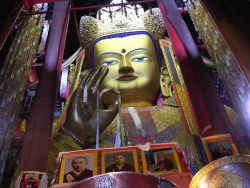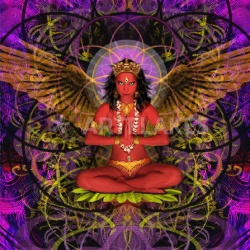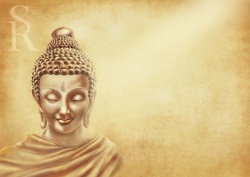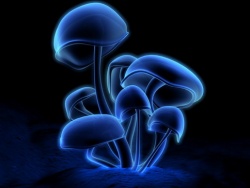Introduction To The Buddhist Path :Tantra
Introduction To The Buddhist Path
We seek your blessings to actualize, in this life, the path of unity,
Of clear light and illusory body which arise from placing your feet
Our protector, at the very center of the central channel and
The eight petalled lotus at your heart.
Introduction To Tantra
Buddhist Tantra is the most advanced level practice in Buddhism. There are numerous differences between Sutrayana and Tantra, where Tantra emphasizes the use of very subtle energies of the mind, of wind, and of the channels. Generally speaking, there are four enlightened qualities in Tantra, which include: the environment, body, objects, and deeds. Because the practice of these qualities exist only in Tantra, this creates a key distinction between Tantra and Sutra.
For example in Tantra:
- The environment consists of a mandala
- The body involves deity yoga
- Objects means being surrounded by dakas, dakinis and other enlightened qualities
- Deeds are the activities
There are four types of Tantra:
These four types of Tantra are differentiated by how each use attachment as part of the Path. In Tantra, negative emotions, such as attachment and anger, are still seen as negative (like in Mahayana and Hinayana) and yet, these emotions are also seen as offering a great opportunity on the Path to Enlightenment. When a practitioner has sufficient skills, working with these negative emotions are seen as a valuable method to reach enlightenment.
Enlightened qualities can be described many different ways, one of which includes the truth body (Dharmakaya), enjoyment body (Sambhogakaya), and emanation body (Nirmanakaya). In yoga and especially in highest yoga tantra there are numerous practices for achieving the three kayas.
There are three stages of the three kayas, which include the foundation, the path, and the result. We all possess internal resources to practice the three kayas, and one of the practices utilizes the death and dying, bardo, and rebirth process. This cycle of reincarnation is one which Buddhists believe all human beings will pass through and offers a powerful opportunity for practice. The three kayas relate to the three stages of this cycle, with death and dying process being Dharmakaya; the intermediate states being Sambhogakaya; and rebirth is Nirmanakaya.
For example, when a person is doing the practice of deity yoga, before a they see themselves as the deity, they dissolve the elements of themself into the nature of the mind, which is called the death process meditation. The actual death process is imagined as though it were actually happening and the subtle consciousness dissolves into clear light, which is the path of Dharmakaya. From this point, there is a process where light or a Sanskrit syllable (relating to the deity of the practice) will arise from the Dharmakaya.
This is the Bardo stage, the path of Sambhogakaya. Which syllable or light it is will depend on which deity yoga you are practicing, and the syllable or light will dissolve and transform into the deity, who arises from that which is dissolving. This comprises rebirth and is the path of Nirmanakaya. The result of the three kayas is the realization of enlightened qualities: the truth body or Dharmakaya, enjoyment body or Sambhogakaya, and the emanation body or Nirmanakaya.
Stages of the Tantric Path
Before beginning Tantra a person must understand and undertake the common Buddhist practices, which are described in the Lam Rim (Stages of the Path to Enlightenment). A person should have a profound practice of renunciation, a clear understanding of Bodhicitta, and be willing to take the vows of Tantra. For example, if someone begins the Tantric practice of deity yoga, they should receive the
initiation for that deity. Before the initiation, the person should have received the Tantric vows. To receive the tantric vows, a person must take the Bodhisattva vows. Before taking the Boddhisattva vows, a person should either take the lay vows or the monks and nuns vows. These are the steps (in reverse) that need to be taken to enter the Tantric Path.
If you wish to practice Tantra, it is essential to find a guru (teacher). The teacher is required for you to receive an initiation. First, you need to identify the deity yoga you would like to practice and then identify a teacher who has an unbroken lineage in that practice. After you receive the initiation of the deity, there are two distinct levels of practice relating to the deity. The first level is called the generation stage and the second is the completion stage of practice.
The generation stage is the path of the three kayas, which were mentioned earlier. In this stage, through strong concentration, you are imagining yourself as a deity within a mandala, and visualizing yourself as the deity in a process of the three kayas (death and dying, bardo, and rebirth). This stage is called generation stage. The generation stage also comprises two mental stages. In the beginning a person will imagine the deity and mandala, and gradually over time will begin to visualize this image vividly for hours, with no interruption in the thoughts.
When a person can sustain this degree of detail for three hours, in combination with the common practices (loving-kindness, compassion, and wisdom) you are in the coarse level of the generation stage. Then when a person is able to reduce the mandala and deity to a miniscule size, while sustaining full details for three hours, you have achieved the subtle practice of generation stage. In the subtle practice of generation stage, a person is ready to move on to the second stage, which is the completion stage.
Whereas in the generation stage a person is practicing deity yoga and visualizing the energy flowing in the central channel accompanied by inner bliss and wisdom, in the completion stage, the subtle air actually enters the central channel (no longer merely visualization). The two nostrils gradually stop and the central channel fully opens, with the air remaining in the central channel and dissolving into the central channel. The tremendous inner bliss generated is inseparable from wisdom (emptiness/sunyata) and arises spontaneously. The air itself arises and dissolves within the central channel, and simultaneously, the inseparable union of inner bliss and wisdom are sustained over a long period of time.
Whereas the generation stage is divided into two levels, the completion stage is divided into six levels[1], which include dissolving the body, dissolving the speech, dissolving the mind, realizing the illusory body, realizing clear light, and union.
Where a person finds themselves in relation to the first five levels (body, speech, mind, illusory body, and clear light) is dependent on the degree of openness of the chakras and channels. As the energy within a person reaches deeper and more profound levels, and as the channels open further, inner bliss and wisdom become increasingly powerful. The final stage, union, identifies that the completion stage is fully realized, and a person has achieved the level of Vajradhara, full Enlightenment.
Footnotes
- ↑ Some traditions will unite the dissolution of body and speech, which totals five levels. Here we are dividing into six levels.



